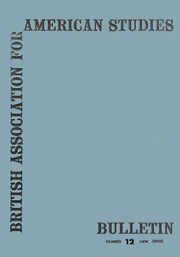No CrossRef data available.
Article contents
Recent Writing on Utah and the Mormons
Published online by Cambridge University Press: 17 February 2011
Extract
When, in 1842, Henry Caswall wrote The City of the Mormons, he stated in his preface that his book was “presented to the Christian public with a deep sense, on the author's part, of the iniquity of an imposture which, under the name of religion, is spreading extensively in America and Great Britain”. A few years later, probably in 1850, John Bowes wrote a pamphlet to show that Mormonism was simply a swindle to put money into the pockets of the Church's leaders. His title was Mormonism Exposed, in its swindling and licentious abominations, refuted in its principles and in the claims of its head, the modern Mohammed, Joseph Smith, who is proved to have been a deceiver end no prophet of God; and his chapter, based on the reports of two apostates, on the simple Temple ceremonies of washing, anointing, passwords, grips, oaths, and enacting of the Creation story, was uncompromisingly headed “Orgies”. As late as 1902, in a preface which contrasted his own factual approach with earlier polemic, William A. Linn's Story of the Mormons included the words, “If the fraudulent character of the alleged revelation to Smith of the golden plates can be established, the foundation of the whole Church crumbles”; and Linn went on to devote a quarter of a very long book to the attempt. In 1957, however, in a lecture in the University of Utah, published as ‘The Mormons in American History’ (Bulletin of the University of Utah, Vol. 48, Ho, 11), William Mulder expressed what is nowadays a far more common view than any of those quoted above. “In its New England origins”, he said, “its Utopian experiments and reforms, its westward drive, and its early expansion to Europe resulting in a great programme of immigration and settlement, nineteenth-century Mormonism expressed prominent traits and tendencies that were already shaping American society. It was not simply a colourful reflection of the times; it was a dynamic reworking of the diverse elements of American culture.”
- Type
- Research Article
- Information
- Copyright
- Copyright © British Association for American Studies 1959




